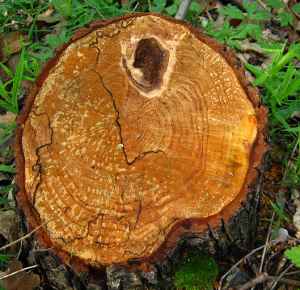How To Make Pine Tar Primitive Skills - Survival Manual
Pine tar has a long history and many uses. It has been used for at least six centuries as a ship and rigging preservative. Pine tar can be used as a sealer or a strainer. It is used to seal and finish lumber seal and preserve fence posts, stain and seal furniture or any wood product such as gun stocks, shelving etc. It is a GREAT way to preserve ropes primitive ropes made of hemp, vines or grass, basically any primitive cordage.
 The first step in making your own pine tar is to find a dead fallen pine tree. Take an ax and shave off the bark from some of the limbs. Start at the trunk of the tree and work your way towards the ends of the branches. When you see the limb wood turn from an orangish color to a more weathered white color go ahead and cut the limb there and discard the white portion all the way to the tip. You are interested in the section that is orangish. So next cut off the remainder of the limb at the trunk and save this portion of the limb. The orange color indicates that the limb still contains recoverable resins to make your tar. So go ahead and collect a fair amount of the wood from your fallen pine tree.
The first step in making your own pine tar is to find a dead fallen pine tree. Take an ax and shave off the bark from some of the limbs. Start at the trunk of the tree and work your way towards the ends of the branches. When you see the limb wood turn from an orangish color to a more weathered white color go ahead and cut the limb there and discard the white portion all the way to the tip. You are interested in the section that is orangish. So next cut off the remainder of the limb at the trunk and save this portion of the limb. The orange color indicates that the limb still contains recoverable resins to make your tar. So go ahead and collect a fair amount of the wood from your fallen pine tree.
For some reason it is best to use dried wood from a dead tree. This seems counterintuitive to me. I would think that a green piece of pine would be preferable, but apparently that is not the case. Actually the tree doesn't have to be dead, sometimes you can reach the lower dead limbs of a live tree and use them. Just be sure the wood hasn't decayed too much and lost its orange color. The old dead branches that break and crumble easily are not what you want to use.
Cut the pine wood into smallish charcoal sized pieces. They do not have to be super small, but fist sized pieces or smaller seem to work the best.
The next thing you will need for this process is a container. It can be metal or stone or anything that will not melt or burn in a fire. The container will need to have holes in the bottom to allow the tar/resin to flow out of the bottom of the container into a collection container. If you are using a metal bucket it is important to punch the holes in the bottom from the inside. If you flip the can upside down and drive a nail into it to make your hole, the hole will have a lip on the inside that will hinder the flow of liquid out of the bottom of the can. However, if you punch the hole from within the bucket the edges of the hole will protrude downward and not hold the liquid up in the can. You can have one hole or several. Just be sure they are not very large. This would allow solids to fall through the hole into you collection container.
Now pack the container with you pine wood pieces. Put as much as possible. Now place the metal lid on your container with the wood inside. Regardless of what type of container you use it is important that it is somewhat sealed to keep oxygen from freely entering the can. If this were to happen you would burn the wood in the can just as you would in a normal fire and no pine tar would be produced... it would all burn up in the fire. So now it should be apparent that not only does the production of pine tar produce the tar, but it has the additional benefit of also producing charcoal as a useful by product.
You will also need another container, a collection container for the pine tar. This container also needs to be fireproof. It does not need to be as large as the container that holds the pine wood. So determine where you will build your fire and dig a hole in the center that is just big enough to fit in the collection container. Putting it underground helps protect it from the high temps of the fire. So be sure the top of the can is level with the ground and not protruding half way out or something.
Place the collection container in the hole and then place the pine packed container directly on top of the collection container. To be clear the collection container is sunk into the ground and the pine packed container is set directly on top so that the hole or holes will allow any liquid to drain straight into the collection container. So do not poke any holes wider aka outside the reach of the collection container.
Now that you have the containers stacked and ready to go, simply cover the containers with smallish pieces of wood. The discarded pine limbs would be a great wood to use for this. Pine burns fast and hot and old dead pine limbs fit this need really well. Add wood as needed to keep the fire going for about two hours. After the fire goes out or after enough time has passed the coals can be spread out to facilitate cooling. Carefully remove the top container and hopefully it will contain lots of charcoal. If not then it is unlikely that you made any pine tar. Now remove the bottom collection container and it should have a black liquid that resembles old used motor oil. This is the pine tar. Woohoo! Congratulations.
If you want to do this on a grander scale after proving to yourself that you can do it at all, then go for it. Historically this collection of pine tar was sometimes done on a truly grand scale where the pine to be extracted from was processed in huge earthworks that were about 20 feet across.
I am unsure of exactly how it was done historically but the process described above is easily expanded. I envision something along the lines of the following.
Bury a large container. Form a funnel either out of metal or clay over the top of the container with only a small hole to allow liquid to flow into the container or drum. Stack your pine wood on top of the funnel. Encase the pine in clay or if available use a huge metal drum. This includes the top. Now cover with lots of wood and light wood and light it and cross your fingers.
It is important to note that if your pine and collection container are completely sealed there is the very real possibility that pressure could build up and cause a sort of explosion. As long as there is some sort of ventilation for the pine container then there is no danger. It is actually difficult to get a perfect seal if you are doing this with natural materials but if you are using industrial metal containers then the danger is very real. Whereas a clay container will fracture and rupture at a low pressure industrial metal containers could build up quite a bit of pressure before exploding.

For some reason it is best to use dried wood from a dead tree. This seems counterintuitive to me. I would think that a green piece of pine would be preferable, but apparently that is not the case. Actually the tree doesn't have to be dead, sometimes you can reach the lower dead limbs of a live tree and use them. Just be sure the wood hasn't decayed too much and lost its orange color. The old dead branches that break and crumble easily are not what you want to use.
Best Wood For Pine Tar "Fatwood"!
Fatwood is dried wood that is still full of resin. The best tree for fatwood is Longleaf pine but most conifers will do. The best fatwood is the stumps of dead pine trees, meaning the yield is highest from this wood, but don't worry if you can't get this wood. Any Pine will do, you just might need to process more wood to get the same amount of pine tar.
If you cut down a pine tree or if you find one that has been broken by a storm, then before the roots die they will pump all of the resin in the roots up in an effort to save the tree. So the end result is high resin content in the stump.
Pine resin contains terpene which is highly flammable so fatwood shavings are easy to ignite and therefore make excellent tinder.
Fatwood is dried wood that is still full of resin. The best tree for fatwood is Longleaf pine but most conifers will do. The best fatwood is the stumps of dead pine trees, meaning the yield is highest from this wood, but don't worry if you can't get this wood. Any Pine will do, you just might need to process more wood to get the same amount of pine tar.
Pine resin contains terpene which is highly flammable so fatwood shavings are easy to ignite and therefore make excellent tinder.
Cut the pine wood into smallish charcoal sized pieces. They do not have to be super small, but fist sized pieces or smaller seem to work the best.
The next thing you will need for this process is a container. It can be metal or stone or anything that will not melt or burn in a fire. The container will need to have holes in the bottom to allow the tar/resin to flow out of the bottom of the container into a collection container. If you are using a metal bucket it is important to punch the holes in the bottom from the inside. If you flip the can upside down and drive a nail into it to make your hole, the hole will have a lip on the inside that will hinder the flow of liquid out of the bottom of the can. However, if you punch the hole from within the bucket the edges of the hole will protrude downward and not hold the liquid up in the can. You can have one hole or several. Just be sure they are not very large. This would allow solids to fall through the hole into you collection container.
Now pack the container with you pine wood pieces. Put as much as possible. Now place the metal lid on your container with the wood inside. Regardless of what type of container you use it is important that it is somewhat sealed to keep oxygen from freely entering the can. If this were to happen you would burn the wood in the can just as you would in a normal fire and no pine tar would be produced... it would all burn up in the fire. So now it should be apparent that not only does the production of pine tar produce the tar, but it has the additional benefit of also producing charcoal as a useful by product.
You will also need another container, a collection container for the pine tar. This container also needs to be fireproof. It does not need to be as large as the container that holds the pine wood. So determine where you will build your fire and dig a hole in the center that is just big enough to fit in the collection container. Putting it underground helps protect it from the high temps of the fire. So be sure the top of the can is level with the ground and not protruding half way out or something.
Place the collection container in the hole and then place the pine packed container directly on top of the collection container. To be clear the collection container is sunk into the ground and the pine packed container is set directly on top so that the hole or holes will allow any liquid to drain straight into the collection container. So do not poke any holes wider aka outside the reach of the collection container.
Now that you have the containers stacked and ready to go, simply cover the containers with smallish pieces of wood. The discarded pine limbs would be a great wood to use for this. Pine burns fast and hot and old dead pine limbs fit this need really well. Add wood as needed to keep the fire going for about two hours. After the fire goes out or after enough time has passed the coals can be spread out to facilitate cooling. Carefully remove the top container and hopefully it will contain lots of charcoal. If not then it is unlikely that you made any pine tar. Now remove the bottom collection container and it should have a black liquid that resembles old used motor oil. This is the pine tar. Woohoo! Congratulations.
If you want to do this on a grander scale after proving to yourself that you can do it at all, then go for it. Historically this collection of pine tar was sometimes done on a truly grand scale where the pine to be extracted from was processed in huge earthworks that were about 20 feet across.
I am unsure of exactly how it was done historically but the process described above is easily expanded. I envision something along the lines of the following.
Bury a large container. Form a funnel either out of metal or clay over the top of the container with only a small hole to allow liquid to flow into the container or drum. Stack your pine wood on top of the funnel. Encase the pine in clay or if available use a huge metal drum. This includes the top. Now cover with lots of wood and light wood and light it and cross your fingers.
It is important to note that if your pine and collection container are completely sealed there is the very real possibility that pressure could build up and cause a sort of explosion. As long as there is some sort of ventilation for the pine container then there is no danger. It is actually difficult to get a perfect seal if you are doing this with natural materials but if you are using industrial metal containers then the danger is very real. Whereas a clay container will fracture and rupture at a low pressure industrial metal containers could build up quite a bit of pressure before exploding.


